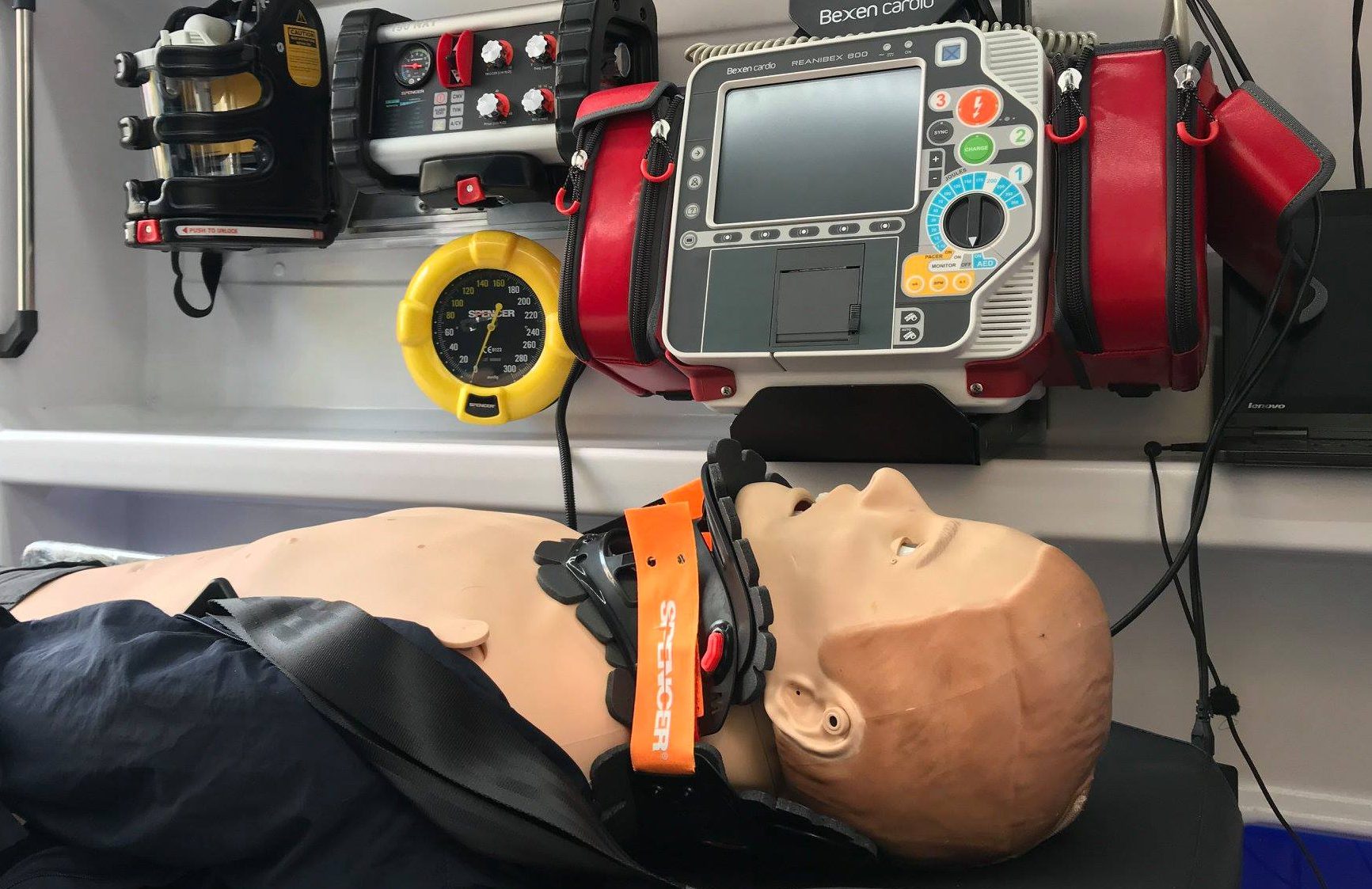
Cervical Collars : 1-piece or 2-piece device?
Cervical collar: let us see which are the best ones to have into the ambulance to observe the protocols.
- What is the immobilization and with what tools is it performed?
- Size: so important?
- How is the cervical collar applied in an emergency?
- When is the cervical collar well applied?
- What damages can derive from the bad application of a cervical collar?
- The video about cervical collar application according to AREU
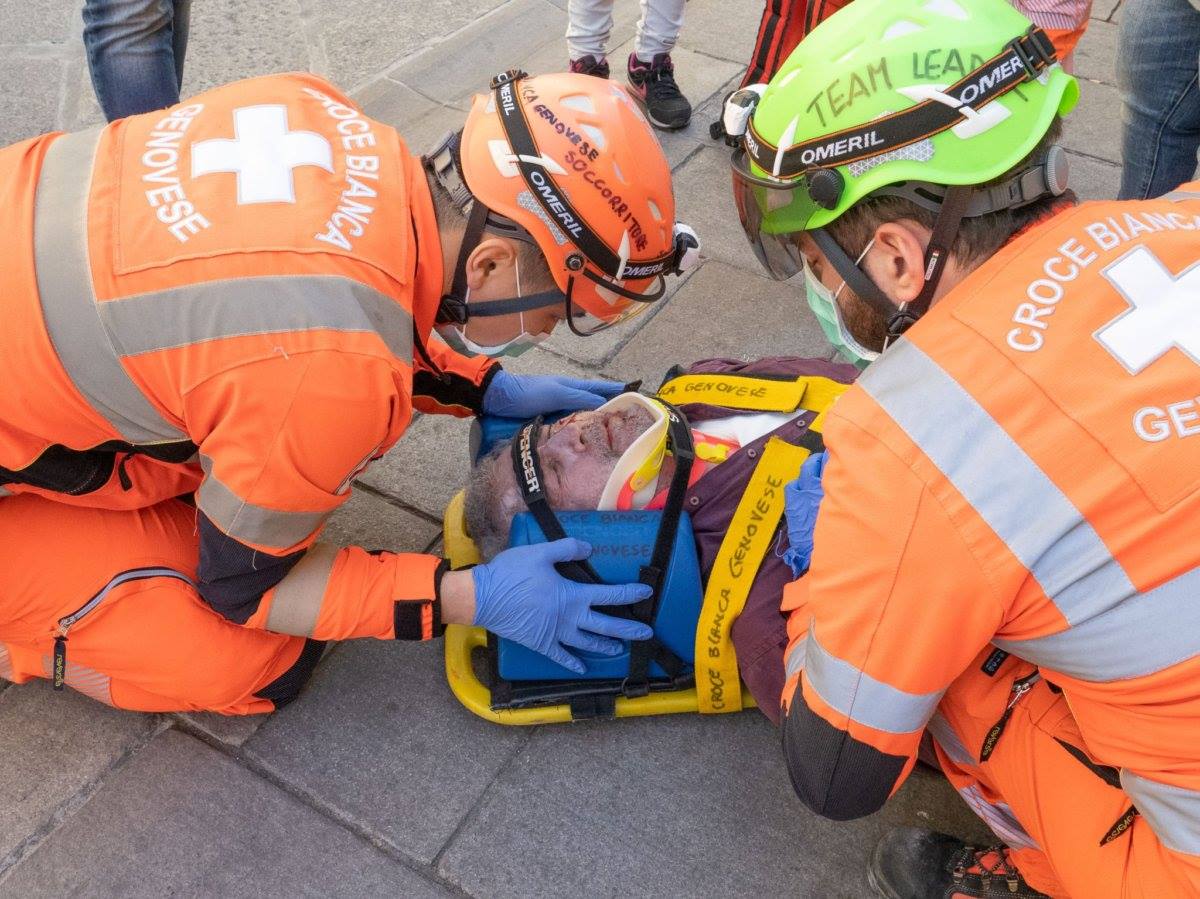 Do you know what you are applying to the neck of your trauma patient? Cervical collars are not all the same, so let us go see the differences between one-piece (or mono-valve) and bi-valve collar. As you well know, in the last years much debate arose on the topic of immobilization. On the one hand, there are the ones who consider it obsolete and – at times – even harmful to the patient. On the other hand, there are the ones that continue with conviction to practice extrication and immobilization of the patient as a precautionary measure. In between there are the current protocols – which must always be observed. Medical devices suppliers must develop products that are more and more comfortable, effective and designed to improve the patient conditions. And they must also work in compliance with tens (even hundreds) of different protocols of action. Such products aim to reduce the weight of the head on the cervical vertebrae and to protecting this area from secondary injury and inconvenient movements. To this day the axiom of medical aid – in Countries with EMT and Volunteers on the ambulance – is: “A cervical collar should be applied to all the trauma patients until any cervical spine injury is ruled out.” In fact, the cervical collar is used because – according to some scientific research – it is necessary to limit the involuntary movements when the patient has cervical column trauma. That amounts to the 2-4% of all trauma patients, among whom potentially 20% has a spinal cord injury.
Do you know what you are applying to the neck of your trauma patient? Cervical collars are not all the same, so let us go see the differences between one-piece (or mono-valve) and bi-valve collar. As you well know, in the last years much debate arose on the topic of immobilization. On the one hand, there are the ones who consider it obsolete and – at times – even harmful to the patient. On the other hand, there are the ones that continue with conviction to practice extrication and immobilization of the patient as a precautionary measure. In between there are the current protocols – which must always be observed. Medical devices suppliers must develop products that are more and more comfortable, effective and designed to improve the patient conditions. And they must also work in compliance with tens (even hundreds) of different protocols of action. Such products aim to reduce the weight of the head on the cervical vertebrae and to protecting this area from secondary injury and inconvenient movements. To this day the axiom of medical aid – in Countries with EMT and Volunteers on the ambulance – is: “A cervical collar should be applied to all the trauma patients until any cervical spine injury is ruled out.” In fact, the cervical collar is used because – according to some scientific research – it is necessary to limit the involuntary movements when the patient has cervical column trauma. That amounts to the 2-4% of all trauma patients, among whom potentially 20% has a spinal cord injury.
What is cervical immobilization and with what device is it performed?
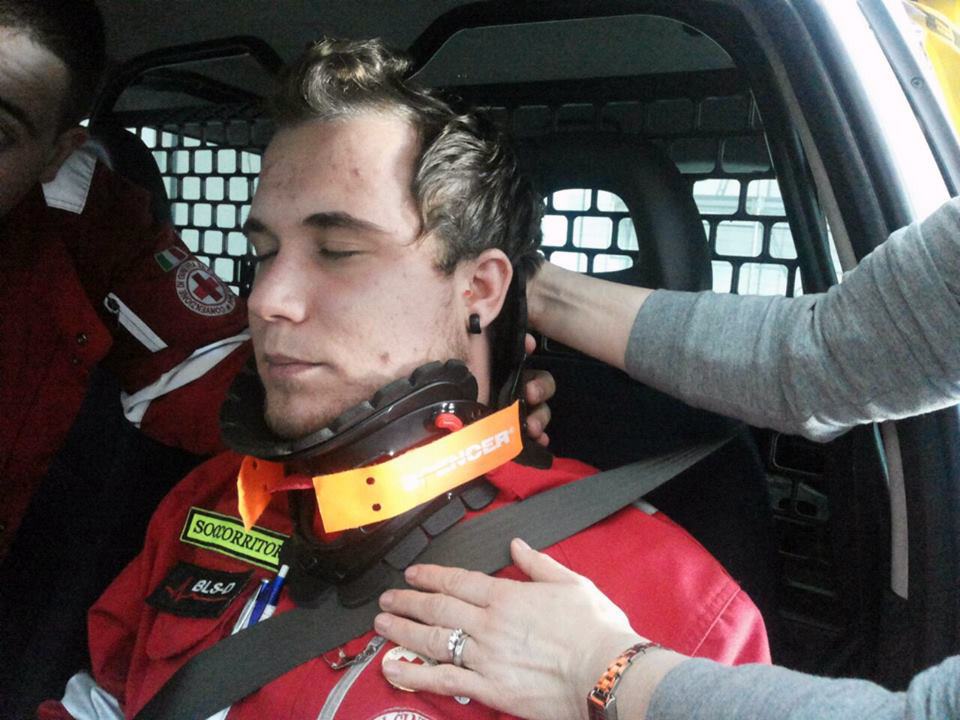 It is best to analyze in detail the medical devices used to perform immobilization, beginning from the most known and used, not only for emergencies but also for other health issues: the cervical collar. Also known as “neck brace”, this device is used to reduce the movements of the cervical vertebrae located in the neck. Consequently, this device alone is not enough for a complete immobilization of the rachis. Instead, in most protocols its usage is combined with other immobilization devices, such as the spinal board, the Kendrick Extrication Device or the vacuum mattress.
It is best to analyze in detail the medical devices used to perform immobilization, beginning from the most known and used, not only for emergencies but also for other health issues: the cervical collar. Also known as “neck brace”, this device is used to reduce the movements of the cervical vertebrae located in the neck. Consequently, this device alone is not enough for a complete immobilization of the rachis. Instead, in most protocols its usage is combined with other immobilization devices, such as the spinal board, the Kendrick Extrication Device or the vacuum mattress.
What kind of cervical collars are commercially available?
The cervical collar is used for the treatment of a most important and delicate part of the body. For this reason, there exist different commercially available solutions that more or less fit the first aid activities, the long-time hospitalizations or other purposes. In the emergency field it is common practice to use rigid cervical collars. We can now distinguish between two types of collars:
- One-piece – It is a very simple collar, consisting in a single flexible shell made up of padded plastic. When not used it is flat, which makes it very easy to store it up into the ambulance even in large amounts. It is good to remember that these collars are intended for a single use. Usually, with a simple clip it is possible to bend the front half, which is to be put under the chin. Instead, the back half is to be slid under the patient’s head by a specific technique especially designed to avoid the risk of injuring the patient’s spine.
- Bivalve or two-piece – It is made up of two parts to be joined together by means of two Velcro straps, and makes the application easier, because it is possible to apply the front half and the back half at different moments.
All models of cervical collars used in emergency cases must have front openings to allow the sanitary personnel to monitor the carotid pulse and to execute particular maneuvers, such as the tracheotomy.
Size of the cervical collar: why so important?
The size of the cervical collar is extremely important. Immobilizing a person with a collar that fits too big or too small can lead to two differing problems: on the one hand there is the risk of overstretching the head/neck, due to the stretching of the muscles and of the rachis structure. On the other hand, there is the risk that the cervical collar does not serve its purpose or – even worse – that it hinders other health maneuvers. The logical conclusion is that the more sizes there are, the easier it will be to find the one fitting the patient. In fact, suppliers are moving toward a higher number of sizes or – in some cases – toward cervical collars that can be adjusted before being applied to the patient. Let’s remark that the collar must always be adjusted before its application; that is extremely important. First, one should measure the area of the patient’s neck to decide which collar to use. Then the collar is applied. The situation may be complex under several standpoints, also depending on the kind of patient. But it must always be remembered that when a cervical collar is applied there must be two health workers, not one alone.
How is the cervical collar applied in an emergency?
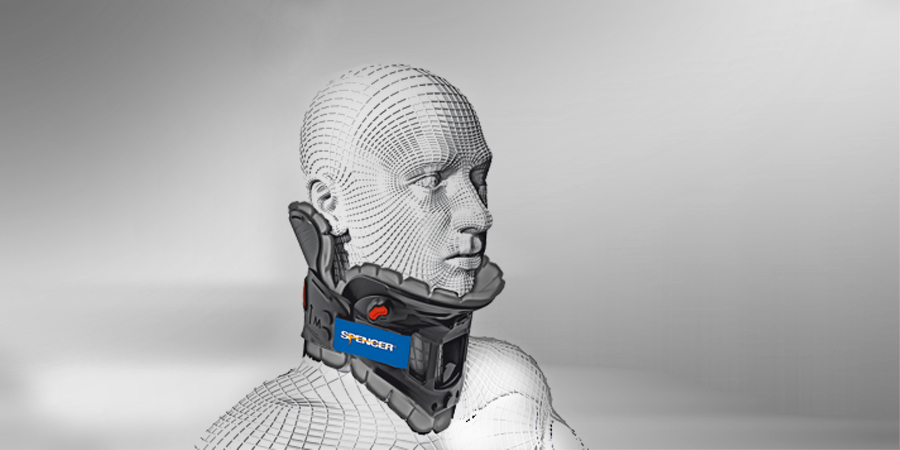 Before applying the collar, one must check if there are earrings, necklaces or clothes that may hinder a correct application. It is always better to remove such accessories. We stated before that there must always be 2 health workers (some protocols require even 3 health workers). The first one places himself behind the patient’s head and holds and immobilizes the head and the neck with his hands, to keep them in neutral position. In such a position the head is perpendicular to the shoulders with respect to all directions. This minimizes the risk of spinal cord injury and maximizes the space available for the spinal cavity into the rachis.
Before applying the collar, one must check if there are earrings, necklaces or clothes that may hinder a correct application. It is always better to remove such accessories. We stated before that there must always be 2 health workers (some protocols require even 3 health workers). The first one places himself behind the patient’s head and holds and immobilizes the head and the neck with his hands, to keep them in neutral position. In such a position the head is perpendicular to the shoulders with respect to all directions. This minimizes the risk of spinal cord injury and maximizes the space available for the spinal cavity into the rachis.
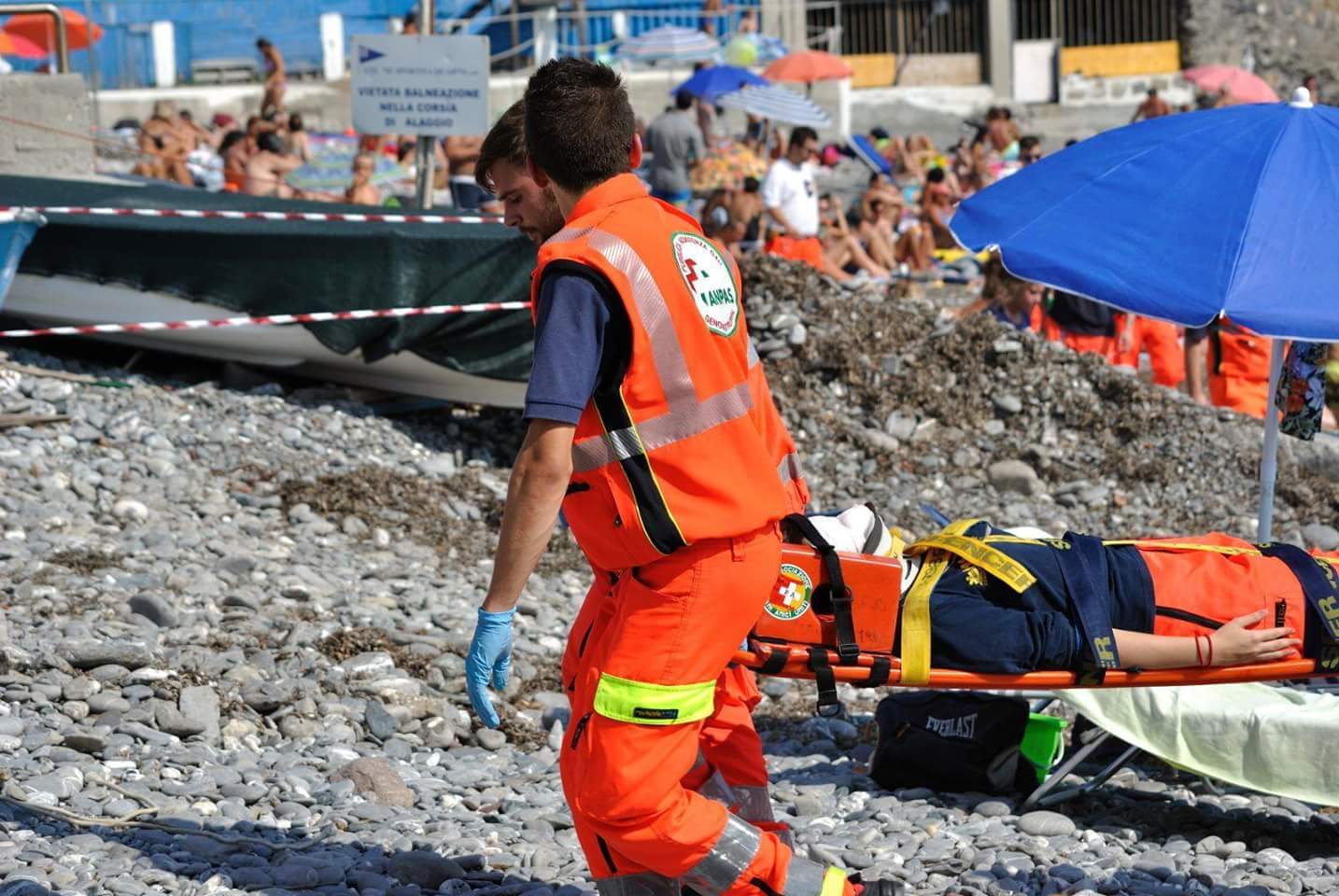 The patient must face upwards, not downwards. The face – perpendicular and looking straight ahead – will continuously be controlled by the second paramedic, who must place himself in front of the patient to apply the collar. While the second paramedic applies the collar, the first one must never lose concentration on the head immobilization. Even after the application of the collar, the head must be kept manually immobilized, since it is a partial-immobilization device. The two-piece cervical collar is applied to the patient so as to create a hollow for the patient’s mandible and chin. First, the front half is applied, then the Velcro straps are passed behind the neck to secure the collar well around the patient’s rachis. This will prevent any head flexion and will allow the paramedics to add the back half of the collar. Once the external Velcro straps fastenings are secured, no extension is possible. If the size is the right one and if the application was correctly performed, the patient will not feel any trouble, nor will there be any obstacle to breathing and swallowing.
The patient must face upwards, not downwards. The face – perpendicular and looking straight ahead – will continuously be controlled by the second paramedic, who must place himself in front of the patient to apply the collar. While the second paramedic applies the collar, the first one must never lose concentration on the head immobilization. Even after the application of the collar, the head must be kept manually immobilized, since it is a partial-immobilization device. The two-piece cervical collar is applied to the patient so as to create a hollow for the patient’s mandible and chin. First, the front half is applied, then the Velcro straps are passed behind the neck to secure the collar well around the patient’s rachis. This will prevent any head flexion and will allow the paramedics to add the back half of the collar. Once the external Velcro straps fastenings are secured, no extension is possible. If the size is the right one and if the application was correctly performed, the patient will not feel any trouble, nor will there be any obstacle to breathing and swallowing.
When is the cervical collar well applied?
After the collar is applied, one should make sure that the application was well performed. You should verify that the collar is in contact with certain body parts as follows:
- The front part must be in contact with the sternum manubrium, with the lower portion of the mandible, and laterally it must level with the collarbone and the lower portion of the horizontal ramus of the mandible.
- The back part must be in contact with the area of the back between the scapulae, while the occipital area of the head and the two Velcro straps must correspond to the fastening point on the front part of the collar.
What should alarm me when I am applying a cervical collar?
 The patient may have cervical damage caused by a trauma and the paramedic may not realize it until he begins the maneuvers for the application of the collar. Therefore, one must look out – since the beginning of the procedure to put the head in neutral position – for possible muscular spasms or neck and back pains. Moreover, if respiratory activity is arrested prejudicing the patency of the airways, if the patient keeps the head rigid in another position or if there are visible lesions to the trachea or to the blood vessels, a doctor must be consulted before proceeding.
The patient may have cervical damage caused by a trauma and the paramedic may not realize it until he begins the maneuvers for the application of the collar. Therefore, one must look out – since the beginning of the procedure to put the head in neutral position – for possible muscular spasms or neck and back pains. Moreover, if respiratory activity is arrested prejudicing the patency of the airways, if the patient keeps the head rigid in another position or if there are visible lesions to the trachea or to the blood vessels, a doctor must be consulted before proceeding.
Obviously, if there are foreign bodies into the soft tissues of the neck, or if it is impossible to keep the neutral position, the patient must be immobilized in the position which he lies in, ensuring first of all that breathing and blood circulation keep steady.
What damages can derive from the bad application of a cervical collar?
Besides irrecoverable damage to the spine, the bad application of the cervical collar on patients can also cause simple operational problems. Not only do we risk making a person paraplegic; we also risk making the job of doctors and nurses complex or even impossible. A cervical collar bad applied can prevent a tracheotomy operation or partially hide possible tracheostomies. It can create breathing problems or make swallowing difficult. Finally – but not last – it can render the patient nervous and cause him pain.
Which cervical collar is the most recommended one?
There is not a one most recommended cervical collar. Every aspect of the emergency and every medical aid is carried out in different situations and following different protocols. It is good to remember that the one-piece collar, though easier to carry along and apply, is often less stable than the two-piece, whose application – instead – calls for an extra maneuver but allows greater precision. When evaluating which device to buy one should also consider the historical records of his association: How many traumas do you deal with every month? How likely is it to take part into medical aids to highway accidents or in maxi-emergency contexts? Were your paramedics trained with one-piece or two-piece collars? And along with those questions one should think to this: How much room do I have at my disposal to store the cervical collars?
Applying a two-piece cervical collar step by step
- The paramedic that leads the operations holds and immobilizes the patient’s head with his hands to keep it in neutral position. The second paramedic, who applies the collar must:
- Stay next to the patient in a convenient position and remove the clothes put around the patient’s neck, along with earrings, necklaces or any other object;
- Check the skin for possible wounds or injury and excludes any contraindications to the application of the collar;
- The paramedic measures the patient’s neck. (The measure starts from the mandible down to the upper edge of the trapezius muscle);
- Verify the size of the collar (trying on the front half of the collar, from the Velcro strap to the lower edge of the collar);
- The paramedic holds the front half of the collar and lightly bend it. Then, he gently puts the collar on the injured person’s thorax, and slides it toward the neck up until it kindly gets under the mandible:
- After applying the upper part, the paramedic slides the connecting straps under the neck and fixes it. Now the chief paramedic shifts his forefingers to hold the device fast in position;
- While the team leader holds the front half fast in position, the paramedic takes the back half and puts it under the patient’s back of the neck;
- Once fed in position, the collar must be secured symmetrically by means of the two Velcro straps, being careful not to jerk them, but always in a gentle way;
- At this point the paramedic asks and verifies that the patient tolerates the collar position without problems, that his breathing is not compromised, that he can open his mouth and that pulse is fine.
- Finally, at the end of the immobilization, you can move the patient on the stretcher, inside the ambulance.
The video about the application of the cervical collar according to AREU (Italian abbreviation for Emergency and Urgency Regional Agency). The video show how to apply a Cervical Collar in a proper way.



